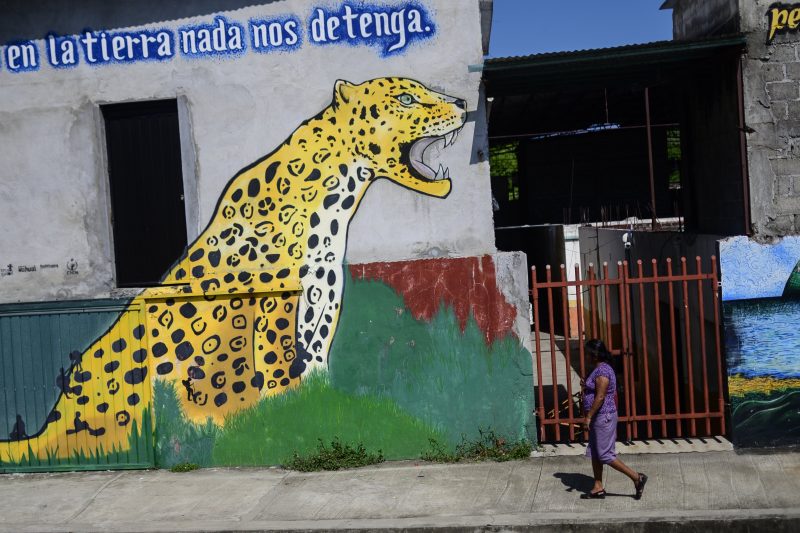Hopes dim for C. American migrants at Mexico’s southern border
A woman walks by a mural in Ciudad Hidalgo, Chiapas State, Mexico, on June 6, 2019 (Pedro PARDO)
Ciudad Hidalgo (Mexico) (AFP) – A graffiti mural welcomes Central Americans who cross the Suchiate River from Guatemala to Mexico: a roaring jaguar protecting a group of trekking migrants, beneath the words: “May nothing on Earth stop us.”
But the real-life migrants being deported across the border in the other direction are a testament to the fact that, under growing pressure from US President Donald Trump, Mexico is intensifying its efforts to do just that.
Mexico’s southern border is 1,138 kilometers (707 miles) of porous, largely unpoliced territory, much of it stretching through the jungle.
It is not very hard to cross for the undocumented Central Americans who have been heading toward the United States in a growing exodus in recent months.
That has provoked the wrath of Trump, who is using the threat of tariffs to force the Mexican government to do more to stop them.
The strategy appears to be working: Mexico has increased migrant detentions, dramatically restricted visas, stepped up military and police patrols in the border region, and agreed Thursday to deploy 6,000 members of its newly created National Guard to reinforce the border.
The crackdown has made reaching the United States an increasingly impossible dream for migrants like Jose Mario, a 53-year-old Honduran man who has just crossed legally into Mexico — with a visa that restricts his movement to the south of the country, far from the US border.
“We decided we’d rather come legally,” he tells AFP on the bridge that spans the river to the Mexican town of Ciudad Hidalgo, in the southern state of Chiapas.
“The migrants who ford the river get caught and deported.”
As if to punctuate his sentence, three buses pull up to take a group of migrants back where they came from.
Their expressionless faces — most of them very young — look out from behind the buses’ tinted windows.
Jose Mario came in a group of around 100 migrants who arrived early Thursday.
He is waiting on the bridge with friends who also plan to apply for a temporary “regional visitor visa,” which will restrict their movement to the southern states — one of the government’s latest initiatives to keep migrants away from the US.
Other migrants wait in a makeshift shelter set up by the authorities, their laundry drying in the sun as their children play outside.
– Police barricades –
The exodus is being driven by desolate poverty and brutal gang violence in Central America’s “Northern Triangle” — El Salvador, Guatemala and Honduras.
Some 300,000 migrants have entered Mexico so far this year, according to the government.
Under pressure from Trump, the Mexican authorities have detained 51,000 of them — a 17-percent increase from the same period last year.
“Trump is right,” a Mexican border officer told AFP, speaking on condition of anonymity.
“Mexico lets them in, gives them benefits. It shouldn’t.”
Mexico’s leftist President Andres Manuel Lopez Obrador took office in December promising to welcome migrants and protect their rights.
But as Trump lashed out, the leader known as “AMLO” changed tack.
In recent weeks, the police presence in southern Mexico has surged. The authorities have staged unprecedented raids to round up undocumented migrants, and put up highway checkpoints.
On Wednesday, they detained hundreds of migrants who had entered Mexico in a caravan.
Migrant detention centers are meanwhile saturated. They have been the scene of riots and breakouts several times in recent weeks.
– Sneaking through –
The Suchiate River is shallow enough to walk across during the dry season. In the rainy season, migrants and merchants pay rafts to take them across its muddy waters illegally — right below the border officers on the bridge.
Cristobal, 38, operates one such raft. He is also a one-time migrant, deported from the US after five years working in the construction industry in Dallas.
“It’s a mix of migrants and locals crossing the river. Sometimes we can’t tell them apart. It’s not our job anyway,” he tells AFP.
The rafts ferry soft drinks, toilet paper, chickens and black-market gasoline.
Once they cross the river, some migrants hide on the back of trucks to sneak past police checkpoints.
Others who can afford it pay human traffickers, or “coyotes” — a business often tied to violent criminal groups.
The going price is about $6,000 per person.
Disclaimer: Validity of the above story is for 7 Days from original date of publishing. Source: AFP.


